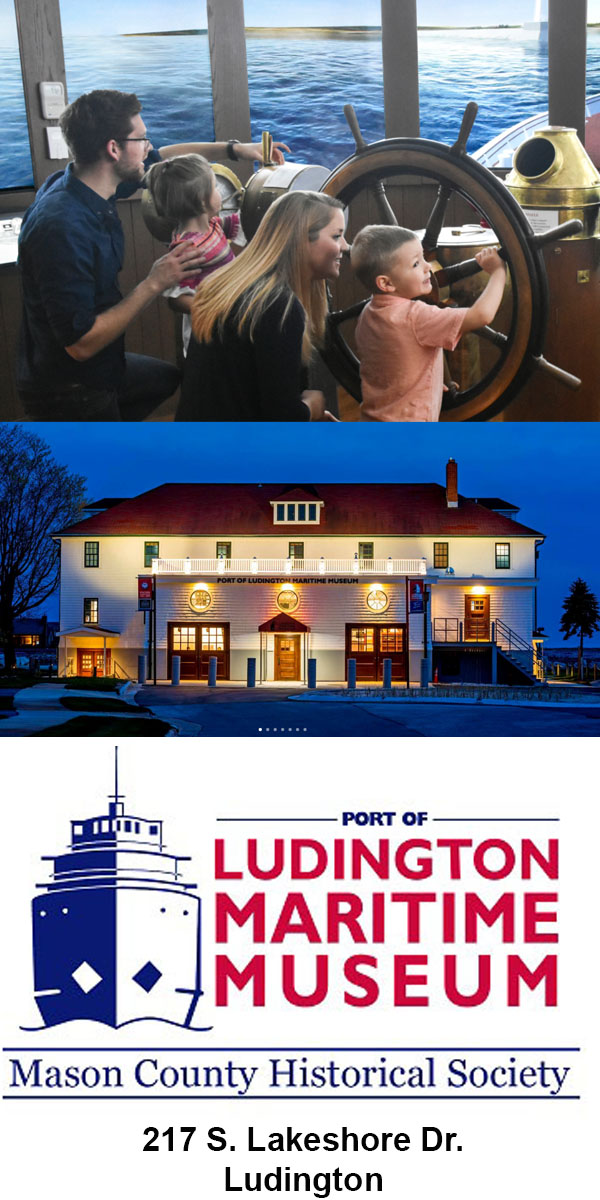
RMS Titanic
Great Lakes History Log is presented by Filer Credit Union with offices in Manistee, Ludington, East Lake, and Bear Lake and the Mason County Historical Society, which operates the Port of Ludington Maritime Museum, Historic White Pine Village and the Rose Hawley Archives in downtown Ludington.
By Rob Alway, Editor-in-Chief
When the R.M.S. Titanic sank on April 14, 1912, the 882-foot ship was under the command of Capt. Edward Smith. But, Smith wasn’t the only captain on board the vessel on that trip. Capt. Edward G. Crosby of Milwaukee, owner of the Muskegon-based Crosby Transportation Company, along with his wife and daughter, was a first class passenger on board the Titanic. Evidence of Crosby’s legacy in the Great Lakes marine industry can be seen to this day through the Muskegon channel, the Milwaukee breakwater, and even a shipping company that continues to operate.

Capt. E.G. Crosby
Edward Gifford Crosby, also known as E.G., was born on Feb. 18, 1842 near Rochester, NY, the son of Warren Crosby (1808-1891) and Amy Crosby (1804-1873).
He attended Lima Academy for two years. His family moved to Michigan in 1856. In 1860, he moved to Lenawee County.
In 1861, he enlisted in the First Michigan Cavalry, commanded by Col. Thornton F. Broadhead and saw action in several Civil War battles including Second Bull Run, Antietam, Gettysburg and the Wilderness campaign. The First Michigan Cavalry was part of the Michigan Brigade, led by Brigadier Gen. George Armstrong Custer. Crosby was discharged in 1864.
Following the war, he married Catherine Elizabeth Halstead (1848-1920) of New York. Catherine Halstead was born on Oct. 26, 1847, in Waterloo, NY, the daughter of Joseph and Martha Halstead.
Census records indicate that in 1870 the Crosbys were living in Seneca, Lenawee County, Michigan and E.G. was working in a saw mill.
E.G. and Catherine had three children: Martha A. “Mattie” (1870-1880); Harriette Rebecca (1873-1941); and Frederick Gifford (1881-1966). Mattie died at the age of 10 after being stricken with acute appendicitis in 1880.
The couple moved to Muskegon in 1871 where Crosby served as superintendent for the Muskegon Boom Company. In 1880, he worked in a saw mill.

The S.S. Nyack, one of the Crosby Line’s first vessels.
He eventually purchased a tugboat. In 1881, he established E.G. Crosby and Company with Capt. Robert Rice and Joseph Hitchcock. The firm transferred lumber from the sawmill docks on Muskegon Lake to the G.R. & I. dock using scows.
The company was awarded government contracts for several navigational projects on Lake Michigan including the construction of the Muskegon channel and the Milwaukee breakwater.
In 1893, Crosby took over the McElroy Transportation Co., established in 1887 by R.B. McElroy. The shipping company served as a connection for the Grand Rapids & Indiana Railroad from Muskegon to Milwaukee. Crosby added freight from the Chicago & West Michigan Railway using a new dock in Muskegon.
In 1896, Crosby established the Crosby Transportation Company, which was incorporated in 1903.
The Detroit, Grand Rapids & Western Railroad and the Chicago & West Michigan Railroad had been operating the S.S. Muskegon car ferry from Muskegon to Milwaukee from 1897 to 1900. The vessel had originally operated on Lake Erie as the Shenango No. 2. The two railroads would merge with the Flint & Pere Marquette Railway in 1900 and form the Pere Marquette Railway.
In 1903, Crosby formed the Grand Trunk Car Ferry Line, a subsidiary of the Grand Trunk Western Railroad, and ordered a vessel, the Grand Haven. However, in 1905, the company defaulted on its bonds and the ship was put into receiver’s auction. It was bought by the railroad and re-incorporated as the Grand Trunk Milwaukee Car Ferry Company, ending Crosby’s venture into the car ferry business. He continued cross-lake shipping, however, with the steamers Nyack, E. G. Crosby, Conestoga and May Graham.
 The Crosbys lived in Muskegon until 1897 when they moved to Milwaukee where they purchased a home near the waterfront at 474 North Marshall Street.
The Crosbys lived in Muskegon until 1897 when they moved to Milwaukee where they purchased a home near the waterfront at 474 North Marshall Street.
By 1912, E.G. had been retired from his company. He and Catherine, along with their daughter Harriette, were on vacation in Europe. Harriette had spent two years studying music in Paris. They had returned passage to New York aboard another ship but ran into E.G.’s friend and business associate Charles M. Hays and his entourage who were on business and vacationing in England. Hays and his group had been invited aboard the Titanic by Joseph Bruce Ismay, chairman and manager of the White Star Line.
Hays was president of the Grand Trunk Railway, which served Grand Haven and Muskegon.
The April 19, 1912, Grand Haven Tribune reported that the Crosbys had intended to return to the U.S. on March 28.

Charles Hays
The three of them boarded the Titanic at Southhampton, England as first class passengers. E.G. and Catherine were registered in cabin B-22 and Harriette was in cabin B-26.
An hour before Titanic struck an iceberg, Crosby, Hays and Colonel Archibald Gracie were relaxing in the Gentlemen’s Smoking Lounge discussing technological advances in transportation and if they posed a danger.
Hays reportedly commented, prophetically, “The trend to playing fast and loose with larger and larger ships will end in tragedy.”
Crosby apparently disagreed and assured the two that the vessels such as Titanic were the future of modern transportation.
Titanic Major Arthur G. Peuchen, who boarded a lifeboat, told a newspaper reporter that he had spoken to Hays moments before he disembarked and the men believed they would be rescued.
“I feel it is good (to stay afloat) for eight hours longer, and by that time, we will have help,” Hays said to Peuchen. “I have just been talking to Captain Crosby, of Milwaukee, a shipbuilder, and he says she cannot possibly go down.”
Carla Hays, Charle Hay’s wife, and their daughter Orian, also boarded a lifeboat. Hays had assured them that Titanic would stay afloat for at least 10 hours.
By 2:20 a.m. the Titanic was gone.

Harriette Crosby
Catherine and Harriette boarded lifeboat No. 7, one of the ship’s 20 lifeboats. They were among 36 passengers and two Titanic crewmen.
Catherine and Harriette Crosby, still in the lifeboat hours later, were rescued by the S.S. Carpathia.
While on the Carpathia, female survivors from another lifeboat said they had seen Capt. Crosby struggling in the water. He apparently refused to accept aid that was offered by the women and children.
Historian and author George Hilton wrote in his book “Lake Michigan Passenger Steamers,” published in 2002, that Crosby remained on the Titanic until it sank, then swam away from it and mounted an iceberg, which is where he ultimately froze to death.
E.G. Crosby’s body was recovered by the MacKay Bennett (No. 269). It was among the 306 bodies found. The vessel Minia recovered the body of Charles M. Hayes. The bodies were transported to Halifax where they were delivered to Howard G. Kelley, an officer of the Grand Trunk Railway. Kelley had travelled to Halifax to arrange transportation of the remains of Hays.
The Carpathia arrived in New York shortly after 9 p.m. on April 18, four days later.
“Captain Crosby’s name does not appear among the lists of those saved from the shipwreck of the Titanic,” the April 18, 1912 edition of the Grand Haven Tribune reported. “It is feared that he went down with the ship.”
A telegram sent to the Crosby Transportation Co. office in Grand Haven on the morning of April 19 confirmed that Crosby had died. The message was published in the Grand Haven Tribune that day.
“It is now certain that Mr. Crosby was among those lost.”
Catherine Crosby provided her testimony during the 18th day of the U.S. Senate inquiry. She stated that hadn’t noticed anything unusual or out of the ordinary in either the equipment of the vessel or in the handling of it until Sunday, April 14, 1912. At that time, she noticed that crew members were taking the temperature of the water on the afternoon of that day, “and it was stated by those engaged in doing this that the temperature of the water was colder and indicated that the boat was in the vicinity of ice fields; this was about the middle of the afternoon, as I recollect,” she stated.

Capt. Edward J. Smith
“At that time my husband and I were walking up and down the promenade deck, which, as I recollect it, was the deck below the hurricane deck, and it was while we were walking up and down this deck that I first noticed these seamen taking the temperature of the water. My husband was a sailor all his lifetime, and he told me all about it, and it was from that that I knew what they were doing. I could see what they were doing. My husband retired at about 9 o’clock that evening, and I retired about 10.30. Elmer Taylor, one of the passengers who went over with us on the steamer, told me afterwards, when we were on the Carpathia, that at the time I retired that night he noticed the boat was going full speed. I had not retired long when I was suddenly awakened by the thumping of the boat. The engines stopped suddenly. This was about 11.30. Capt. Crosby got up, dressed, and went out, and came back again and said to me, ‘You will lie there and drown,’ and went out again. He said to my daughter, ‘The boat is badly damaged; but I think the watertight compartments will hold her up.’ I then got up and dressed, and my daughter dressed, and followed my husband on deck, and she got up on deck, and the officer told her to go back and get on her life preserver and come back on deck as soon as possible. She reported that to me, and we both went out on deck where the officer told us to come. I think it was the first or second boat that we got into. I do not recollect other boats being lowered at that time. I did not see them. This was on the left-hand side where the officer told us to come, and it was the deck above the one on which our staterooms were located; our staterooms were located on the B deck, and we went to the A deck where the officer and lifeboat were. We got into the lifeboat that was hanging over the rail alongside the deck; we got in and men and women, with their families, got in the boat with us; there was no discrimination between men and women. About 36 persons got in the boat with us. There were only two officers in the boat, and the rest were all first class passengers. My husband did not come back again after he left me, and I don’t know what became of him, except that his body was found and brought to Milwaukee and buried.”

The last words E.G. Crosby reported to have said to his wife and daughter was, “I will stay here. You go. If it be fortune to get out of this alive, I will see you again. If not, goodbye.”
Catherine then described the experience on the lifeboat.
“There were absolutely no lights in the lifeboats, and they did not even know whether the plug was in the bottom of the boat to prevent the boat from sinking; there were no lanterns, no provisions, no lights, nothing at all in these boats but the oars. One of the officers asked one of the passengers for a watch with which to light up the bottom of the boat to see if the plug was in place; the officers rowed the boat a short distance from the Titanic, and I was unable to see the lowering of any other boats, and we must have rowed quite a distance, but could see the steamer very plainly; saw them firing rockets, and heard a gun fired as distress signals to indicate that the steamer was in danger; we continued a safe distance away from the steamer, probably a quarter of a mile at least, and finally saw the steamer go down very distinctly; we did not see nor hear about any trouble on the steamer that is reported to have taken place afterwards; we got away first, and got away a safe distance, so that we could not see nor hear what took place, until the steamer went down, which was about 2.20 a. m. on the morning of the 15th; I heard the terrible cries of the people that were on board when the boat went down, and heard repeated explosions, as though the boilers had exploded, and we then knew that the steamer had gone down, as her lights were out, and the cries of the people and the explosions were terrible; our boat drifted around in that vicinity until about daybreak, when the Carpathia was sighted and were taken on board; we had to row quite a long time and quite a distance before we were taken on board the Carpathia; I was suffering from the cold while I was drifting around, and one of the officers put a sail around me and over my head to keep me warm, and I was hindered from seeing any of the other lifeboats, drifting in the vicinity or observe anything that took place while we were drifting around until the Carpathia took us on board: we received very good treatment on the Carpathia, and finally arrived to New York; it was reported on the Carpathia by passengers, whose names I do not recollect, that the lookout who was on duty at the time the Titanic struck the iceberg had said: ‘I know they will blame me for it, because I was on duty, but it was not my fault; I had warned the officers three or four times before striking the iceberg that we were in the vicinity of icebergs, but the officer on the bridge paid no attention to my signals.’ I can not give the name of any passenger who made that statement, but it was common talk on the Carpathia that that is what the lookout said.

S.S. Wisconsin – named the E.G. Crosby at the time of Crosby’s death in 1912.
The S.S. E.G. Crosby, named in honor of the steamer line’s boss, flew its colors at half staff that day in honor of Crosby.
On April 25, employees from the Grand Trunk’s Grand Haven terminal ceased operations for five minutes to pay a silent tribute to Hays. All operations of the Crosby line were suspended April 26, to pay tribute to Capt. Crosby. Flags were also flown at half-mast at government buildings and businesses in Grand Haven.
The funeral for E.G. Crosby was held in Milwaukee on May 7, 1912 aboard the Nyack, flagship of the Crosby Transportation Company fleet. Memorial services were also held in Grand Haven and Muskegon.
His body was cremated and his ashes were interred at Fairview Mausoleum in Milwaukee. Following her death in 1920, Catherine Crosby’s body was entombed beside her husband.
Harriette Crosby married Marvin Persons Gillies on Nov. 8, 1898 in Muskegon. The two were divorced in 1897 and did not have children. The reason listed for the divorce was “husband’s cruelty.”
On Feb. 11, 1912, Harriette gave birth to a daughter, Andrae Crosby (1912-2002). Family ancestry records indicate that the father was Edouard Bourdois (1870-1942), but they were not married. Harriette was living in Los Angeles with Edouard when she died on Feb. 11, 1941. Harriette was entombed with her parents in Milwaukee.
According to records at the Milwaukee Public Library, Fairview Mausoleum was constructed by George L. Thomas in 1912. It was located at 6316 W. Fairview Ave. in Milwaukee.
In 1952, the owners filed for bankruptcy, and the mausoleum fell into disrepair. In 1994, Fairview Mausoleum Maintenance Company, Inc. filed a lawsuit to force the City of Milwaukee to take over the responsibility of the mausoleum grounds. The company stated that they had not been able to take proper care of the grounds for 10 years and that the $100,000 remaining in the Fairview Mausoleum Trust was not enough to continue the maintenance. This lawsuit led to the eventual takeover of grounds operations by the City of Milwaukee.
The mausoleum, originally constructed of black granite, was neglected for years and continued to deteriorate until it was finally condemned in 1996. The necessity to transfer the human remains from the property resulted in a contract with Brett Funeral Home and Graceland Cemetery. All 1,000 human remains, including those of the Crosbys, were transferred from Fairview Mausoleum to the Brett Funeral Home and re-interred in the Graceland Cemetery between December 1996 and May 1997. Although Fairview Mausoleum no longer exists, a pair of large stone pillars placed in Section 11 of the Graceland Cemetery mark the new resting place of those formerly interred at Fairview Mausoleum.
The grave marker of Catherine, Edward, and Harriette Crosby states “Passengers on the Titanic” and is engraved with a ship representing the Titanic. The marker also includes a Titanic Historical Society emblem. The reinterment and memorial were funded by the Titanic Historical Society.
E.G. and Catherine’s son, Frederick, had taken over as president of the Crosby Transportation Company after his father’s retirement. Under Frederick’s leadership, the company expanded its routes and its fleet. However, in 1925, the company faced financial issues with a rival who apparently held the mortgage on three of its ships. In response, the Crosby Transportation Company was reorganized as the Wisconsin & Michigan Transportation Company (W&M), known commonly as the Crosby Line.
Sometime between 1930 and 1935, according to U.S. Census records, Frederick Crosby moved from Milwaukee to Oconomowoc Lake, Wis., about 32 miles away. This coincides with the W&M’s merger with the Pere Marquette Line Steamers (not to be confused with the Pere Marquette Railway, which operated the Ludington-based car ferries) in 1934. The Pere Marquette Line Steamers company was based out of Manistee and operated freight and passenger service out of Manistee, Ludington, and Muskegon to Milwaukee.
It is likely that Crosby retired at this point as the new company, the Wisconsin & Michigan Steamship Company, was now owned by Sand Products, Inc. of Muskegon, which was owned by brothers Mac and Mark McKee.
During the Great Depression, the W&M merged with the Pere Marquette Line (separate from the Pere Marquette Railway), which operated vessels out of Ludington, Manistee, and Muskegon. The new company was called the Wisconsin & Michigan Steamship Company.
The legacy of E.G. Crosby continues today in Muskegon as Sand Products continues to operate its West Michigan Dock & Market Company (Mart Dock), Port City Marine Services, and Aquastar Lake Cruises.

RMS Titanic near Queenstown, Ireland (now Cobh), April 11, 1912
About the R.M.S. Titanic
The R.M.S. Titanic was laid down on March 31, 1909 at Harland & Wolf shipyard in Belfast, Northern Ireland, for the White Star Line, and launched on May 31, 1911. She was completed on April 2, 1912. The ship was 882 feet, 9 inches long, 92 feet, 6 inches wide, 175 feet high, with a draft of 34 feet, 7 inches.
She operated with 24 double-ended and five single-ended boilers feeding two 30-feet tall triple-expansion reciprocating steam engines operating the two wing propellers and a low pressure Parsons turbine for the center propeller. The engines’ output was 46,000 hp. She could operate at 21 knots (24 mph) and had a capacity of 2,453 passengers and 874 crew, a total of 3,327 people. She was equipped with 20 lifeboats, sufficient for 1,178 people.
The name Titanic (hull No. 401) derives from the Titans of Greek mythology. The Titanic was the second of three Olympic-class ocean liners. The first, the Olympic (hull No. 400), began operating on June 14, 1911 and operated until April 12, 1935. The third ship, H.M.H.S. Britannic (hull No. 433), began service on Dec. 23, 1915 and was sunk by a German naval mine on Nov. 21, 1916, during World War I, near Kea in the Aegean Sea. Britannic was the largest ship lost in World War I. The sinking cost the lives of 30 of 1,066 people on board.
The three ships were the largest ships ever built to date. The Titanic was slightly larger in gross tonnage, as was the Britannic.
The British White Star Line had a fleet of 29 steamers and tenders in 1912. Its parent company was International Mercantile Marine Co., which was controlled by American financier J. Pierport Morgan.
The three ships had first-class accommodations that included a gymnasium, swimming pool, smoking rooms, restaurants and cafes and a Turkish bath.
The Titanic’s captain was Edward John Smith (1850-1912). Smith joined the White Star Line as an officer in 1880. He had previously served in the British Merchant Navy. He served as the captain of several White Star Line vessels and was chosen to skipper many of them on their maiden voyages. He had served in the Royal Navy Reserve during the Second Boer War, transporting British troops to the Cape Colony.
Though the Titanic’s homeport was Liverpool, England, which was the location of the White Star Line’s home office, the company also operated out of Southhampton, England, which is where she would depart on her maiden voyage.
White Star Line’s initial plans for Olympic and Titanic on the Southampton run followed the same routine as their predecessors had done before them. Each would sail once every three weeks from Southampton and New York, usually leaving at noon each Wednesday from Southampton and each Saturday from New York, thus enabling the White Star Line to offer weekly sailings in each direction. Special trains were scheduled from London and Paris to convey passengers to Southampton and Cherbourg respectively. The deep-water dock at Southampton, then known as the White Star Dock, had been specially constructed to accommodate the new Olympic-class liners, and had opened in 1911.

RMS TItanic
On her maiden voyage, Titanic had 1,317 passengers: 324 in first class; 284 in second class and 709 in third class. There were 869 males and 447 females, which included 107 children. The ship could have accommodated 2,453 passengers: 833 first class; 614 second class; and 1,006 third class. A national coal strike in the United Kingdom caused disruptions to shipping schedules in the spring of 1912, which caused many crossings to be cancelled. Many would-be passengers chose to postpone their travel plans until the strike was over. The strike finished a few days before the Titanic set sail.
The Titanic left Southhampton at noon on April 10, 1912. She then travelled 89 miles across the English Channel to the French port of Cherbourg with four hours of leaving Southhampton.
At 11:30 a.m. on Thursday, April 11, Titanic arrived at Cork Harbor on the south coast of Ireland near the port city of Queenstown, now Cobh. She departed at 1:30 p.m.
The ship was scheduled to arrive at Pier 59 in New York City on the morning of April 17, 1912.
At 11:40 p.m. on April 14, 1912 — about 2,070 miles into her 3,320 mile journey — lookout Frederick Fleet spotted an iceberg immediately ahead of the ship and alerted the bridge. First Officer William Murdoch ordered the ship to be steered around the iceberg and the engines to be reversed, but it was too late. The starboard (right) side of Titanic struck the iceberg, creating a series of holes below the waterline. The hull was not punctured, but rather dented such that the steel plates of the hull buckled and separated, allowing water to rush in.
Five of the 16 watertight compartments were heavily breached and a sixth was slightly compromised. It soon became clear that Titanic would sink, as the ship could not remain afloat with more than four compartments flooded. She began sinking bow-first, with water spilling from compartment to compartment over the top of each watertight bulkhead as the ship’s angle in the water became steeper.
Between 2:10 and 2:15 a.m., a little over two and a half hours after the ship struck the iceberg, the rate of sinking suddenly increased as the boat deck dipped underwater, and the sea poured in through open hatches and grates, following which the electrical power supply on board stopped after the circuit breakers tripped and the lights flickered and went out.
As the ship’s unsupported stern rose out of the water, exposing the propellers, the ship broke in two main pieces between the second and third funnels, due to the immense forces on the keel. With the bow underwater, and air trapped in the stern, the stern remained afloat and buoyant for a few minutes longer, rising to a nearly vertical angle with hundreds of people still clinging to it, before foundering at 2:20 a.m.
Of the estimated 2,224 people on board the ship, 1,635 died, making it one of the deadliest peacetime maritime disasters in history.
Resources:
“Lake Michigan Passenger Steamers,” by George Hilton
“Red Stacks Over the Horizon,” by James Elliott
Grand Haven Tribune


The Mason County Historical Society is a non-profit charitable organization that was founded in 1937 that does not receive any governmental funding. It owns and operates the Port of Ludington Maritime Museum in Ludington, Historic White Pine Village in Pere Marquette Township, and The Rose Hawley Archives and the Mason County Emporium and Sweet Shop in downtown Ludington.
For more information about donating to and/or joining the Mason County Historical Society, visit masoncountymihistory.org.
____________________
Please Support Local News
Receive daily MCP and OCP news briefings along with email news alerts for $10 a month. Your contribution will help us to continue to provide you with free local news.
To sign up, email editor@mediagroup31.com. In the subject line write: Subscription. Please supply your name, email address, mailing address, and phone number (indicate cell phone). We will not share your information with any outside sources. For more than one email address in a household, the cost is $15 per month per email address.
We can send you an invoice for a yearly payment of $120, which you can conveniently pay online or by check. If you are interested in this method, please email editor@mediagroup31.com and we can sign you up. You can also mail a yearly check for $120 to Media Group 31, PO Box 21, Scottville, MI 49454 (please include your email address).
Payment must be made in advance prior to subscription activation.
We appreciate all our readers regardless of whether they choose to continue to access our service for free or with a monthly financial support.
_____
This story and original photography are copyrighted © 2025, all rights reserved by Media Group 31, LLC, PO Box 21, Scottville, MI 49454. No portion of this story or images may be reproduced in any way, including print or broadcast, without expressed written consent.
As the services of Media Group 31, LLC are news services, the information posted within the sites are archivable for public record and historical posterity. For this reason it is the policy and practice of this company to not delete postings. It is the editor’s discretion to update or edit a story when/if new information becomes available. This may be done by editing the posted story or posting a new “follow-up” story. Media Group 31, LLC or any of its agents have the right to make any changes to this policy. Refer to Use Policy for more information.

































.png)











